2020 年广西民族大学翻译硕士英语考研真题 A 卷
Part I. Basic English Knowledge (30%)
Section A: Multiple choice (20%)
Directions: There are 20 multiple-choice questions in this section. Choose the best
answer to each question. Write your answer on the Answer Sheet.
1. Your advice would be _______ valuable to him, who is at present at his wit's
end.
A. exceedingly
B. excessively
C. extensively
D. exclusively
2. The English 1anguage contains a (an)_______ of words which are comparatively
seldom
used in ordinary conversation.
A. altitude
B. latitude
C. multitude
D. attitude
3. If you plant two orange trees in one square yard of land, the trees' productivity
_________
decline.
A. is related to B. is determined to C. is unlikely to
D. is bound to
4
. Game pie was a (an)________ of this famous restaurant.
A. singularity
B. particularity
C. specialty
D. originality
5
. From the editorial we can gain a clear ________ of the world's thought.
A. prospective
B. perspective
C. prospect
D. prosperity
6
. John complained to the bookseller that there were several pages ________ in the dictionary.
A. missing
B. losing
C. dropping
D. leaking
7
. His long service with the company was ________ with a present.
A. admitted
B. acknowledged
C. attributed
D. accepted
8. The young man was accused of possessing _______ weapons.
A. dead
B. dying
C. deadly
D. deathly
9. Parents are apt to blame schools for the educational _______ of their children.
A. boundaries
B. confinements
C. restraints
D. limitations
10. All the information we have collected in relation to that case _______ very
�
little.
A. adds up to
B. makes up for
C. puts up with
D. comes up with
11. _______ is generally accepted, economic growth is determined by the smooth
development of production.
A. What
B. That
C. It
D. As
12. _______, Henry felt a great weight taken off his mind.
A. His duty was fulfilled
B. His duty fulfilled
C. His duty fulfilling
D. His duty had been fulfilled
13. Only in growth, reform and change, paradoxically enough, _________ to be found.
true
security
A.
can
B. can true security
C. true security is
D. is true security
14. The millions of calculations involved, had they been done by hand, _______ all
practical
value by the time they were finished.
A. could lose
C. might
B. would have lost
D. ought to have lost
15. We didn’t find _______ to prepare for the worst conditions they might meet.
A. worth their while B. its worth C. it
worthwhile D. it worth
16. ________ I like to do science, as a teacher I have to go over the students'
papers and theses.
A. As far as
B. So far
C. In so far as
D. Much as
17. The professor can hardly find sufficient grounds _______ his argument in favor
of the new theory.
A. which to base on
B. on which to base
C. to base on which
D. which to be based on
18. _______ was a well-known fact.
A. That their team being weak
B. Their team as being weak
C. As their team was weak
D. That their team was weak
19. The people is to the people’s army _______ water is to fish.
�
A. what
B. that
C. as
D. so
12. ________ people and objects in this frontier painter’s works are often presented
in a flat, abstract manner.
A. If always able to recognizable
B. While always recognizable
C. Always can be recognized
D. Although can be recognized
Section B: Proofreading and Error Correction (10 %)
Directions: The following passage contains 10 errors. Each indicated line
contains a maximum of ONE error. In each case, only ONE word is involved. You
should proofread the passage and correct it. Please write your answers on the
Answer Sheet.
To live, learn and work successfully in an increasing complex and
information-rich society, students must be able to use technology effectively.
Within an effective educational setting, technology can enable students to
become able information users and effective users of productivity tools
Parents want their children to graduate with skills that prepare them to
either get a job in today’s marketplace and advance to higher levels of education
and training. Employers want to hire employees who are honest, reliable, literary,
and able to reason, communicate, make decisions, and learn. Communities want
schools to prepare their children to become good citizens and productive members
of society in a technological and information-basing world. National leaders,
the U.S. Department of Education, and other federal agencies admit the essential
role of technology in 21st century education.
The challenge facing America’s schools is the empowerment of all children
to function effectively in their future, future marked increasingly with change,
information growth, and evolving technologies. Technology is a powerful tool
with enormous potential for paving high-speed highways from outdated educational
�
systems to systems capable of providing learning opportunities, to better serve
for the needs of 21st century work, communications, learning, and life.
Technology had become a powerful catalyst in promoting learning, communications
and life skills for economic survival in today’s world. Educational leaders
are encouraged to
providing
learning
opportunities
that
produce
technology-capable students.
21.
22.
23.
24.
25.
26.
27.
28.
29.
30.
Part II. Reading Comprehension (50%)
Section A: (30%)
Directions: There are three passages in this section. Each passage is followed
�
by some questions or unfinished statements. For each of them there are four choices
mark A, B, C, and D. You should decide on the best choice and write our answers
on the Answer Sheet.
Passage 1
What makes cells age? Wear and tear, yes. But biologically, says Dr. David
Sinclair, professor of genetics at Harvard Medical School, it is lack of oxygen
that signals cells that it is their time to go. Without oxygen, the energy engines
known as the mitochondria become less efficient at turning physiological fuel like
glucose into the energy that the cells need to function. Eventually they shut down.
But in a paper published in the journal Cell, Sinclair and his colleagues
describe for the first time a compound naturally made by young cells that is able
to make older cells energetic and youthful again. In an experiment in mice, the
team found that giving older mice a chemical called NAD for just one week made
2-year-old-mice tissue resemble that of 6-month-old mice (in human years, that would
be like a 60-year-old's cells becoming more like those belonging to a 20-year-old).
As animals age, says Sinclair, levels of NAD drop by 50%; with less of the
compound, the communication between the cell and its mitochondrial energy source
also pauses occasionally, and the cell becomes easily hurt from common aging attacks
— inflammation, muscle wasting and slower metabolism. By tricking the cell into
thinking it is young again, with adequate amounts of NAD, aging can theoretically
be reversed.
His next step is to put NAD in the drinking water of his mice, and see if they
take longer to develop the typical chronic diseases linked to aging, such as
inflammation, muscle wasting and cancer. The pathway may become an important target
for cancer researchers as well, since tumors typically grow in low-oxygen conditions
and are more common in older patients.
Because NAD is a naturally occurring compound that simply declines with age,
�
Sinclair is optimistic that boosting its levels in people won't have as many
significant negative effects as introducing an entirely new compound might. "If
a body is slowly falling apart and losing the ability to regulate itself effectively,
we can get it back on track to what it was in its 20s and 30s," he says.
31. What will not make cells age?
A. Oxygen.
B. Wear and tear.
C. Lack of oxygen.
D. Less physiological fuel.
13. What is the function of mitochondria?
To produce physiological fuel.
To turn physiological fuel into energy.
To create oxygen in people's body.
To produce cells.
14. What do we know about NAD?
It is an artificial compound.
It is made of young cells.
It can revive older cells.
It can be made in one week.
15. What will happen as animals become older?
Communication between cells disappears.
Levels of NAD nearly drop by half.
The metabolism of the cell becomes faster.
Their cell becomes vulnerable to common aging attacks.
16. Why does Sinclair think boosting levels of NAD won't cause many negative effects?
Because NAD is an entirely new compound to human's body.
Because NAD can resist chronic diseases linked to aging.
Because NAD has been successfully tested on mice.
Because NAD naturally occurs in human's body.
Passage 2
�
Catastrophic volcanic eruptions in Europe may have culled Neanderthals to the
point
where they couldn't bounce back, according to a controversial new theory. Modern
humans, though, squeaked by, thanks to fallback populations in Africa and Asia,
researchers say.
About 40,000 years ago in what we now call Italy and the Caucasus Mountains,
which straddle Europe and Asia, several volcanoes erupted in quick succession,
according to a new study to be published in the October issue of the journal Current
Anthropology. It's likely the eruptions reduced or wiped out local bands of
Neanderthals and indirectly affected farther-flung populations, the team concluded
after analyzing pollen and ash from the affected area. The researchers examined
sediments layer from around 40,000 years ago in Russia's Mezmaiskaya Cave and found
that the more volcanic ash a layer had, the less plant pollen it contained.
“ We tested all the layers for this volcanic ash signature. The most
volcanic-ash-rich layer — likely corresponding to the so-called Campanian
Ignimbrite eruption, which occurred near Naples—had no [tree] pollen and very
little pollen from other types of plants,” said study team member Naomi Cleghorn.
“It's just a sterile layer." The loss of plants would have led to a decline in
plant-eating mammals, which in turn would have affected the Neanderthals, who hunted
large mammals for food.“This idea of an environmental cause for the Neanderthals'
demise has been out in the literature. What we're trying to do is point out a specific
mechanism," said Cleghorn, an anthropologist at the University of Texas, Arlington.
Other theories propose that modern humans played a vital role in the fall of
the Neanderthals, either through competition, warfare, or interbreeding. If the
volcanoes theory is correct the Neanderthals’end was much more tragic: dying slowly
in a cold and desolate landscape bereft of food sources. It’s hard to say what
would have been like to be the last few groups out there, seeing other groups less
and less over the years," Cleghorn said.
�
The Neanderthals were a hardy species that lived trough multiple ice ages and
would have been familiar with volcanoes and other natural calamities. But the
eruptions 440,000 years ago were unlike anything Neanderthals had faced before,
Cleghorn and company say. For one thing, all the volcanoes apparently erupted around
the same time. And one of those blasts, the Campanian Ignimbrite, is thought to
have been the most powerful eruption in Europe in the last 20,000 years. "It's much
easier to adapt to something that's happening over a couple of generations,"
Cleghorn said. “You can move around, you can find other places to live, and your
population can rebound." "This is not that kind of event," she said.“This is unique.
There may also have been small bands of Homo sapiens living in Europe at the
time, Cleghorn said. They too would have been affected by the eruptions. But modern
humans likely avoided extinction because they had larger populations in Africa and
Asia, she said, while most Neanderthals were in Europe around that time. “With
their small population groups, Neanderthals did not really have a great source
population," Cleghorn said. “They didn't really have the numbers and the density
to rebuild their populations after the eruptions.
The researchers acknowledge that there are gaps in the volcanoes theory. For
instance, the time line needs to be better defined—did the volcanic eruptions occur
in a period of months, years, or decades? “At this point, it's impossible to pin
down a reliable date" for the eruptions, Cleghorn said. “We can't say that this
eruption happened 50 years before the next eruption. We just don't have that kind
of resolution." It's also unknown exactly how long it took the Neanderthals to die
out—or how long after the eruptions modern humans began settling Europe in force,
she said.
Anthropologist John Hoffecker, though, suggests that modern humans had already
begun crowding out Neanderthals in Europe long before the eruptions in question.
�

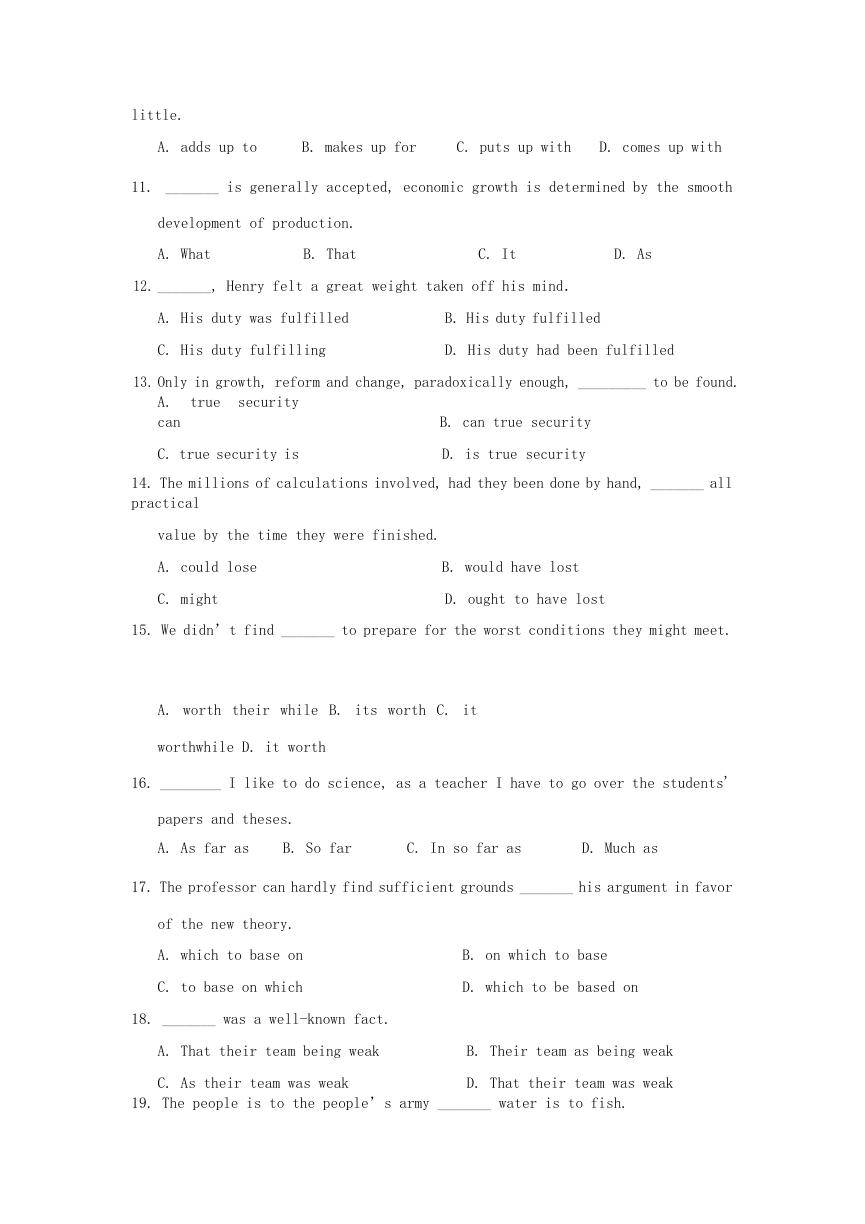

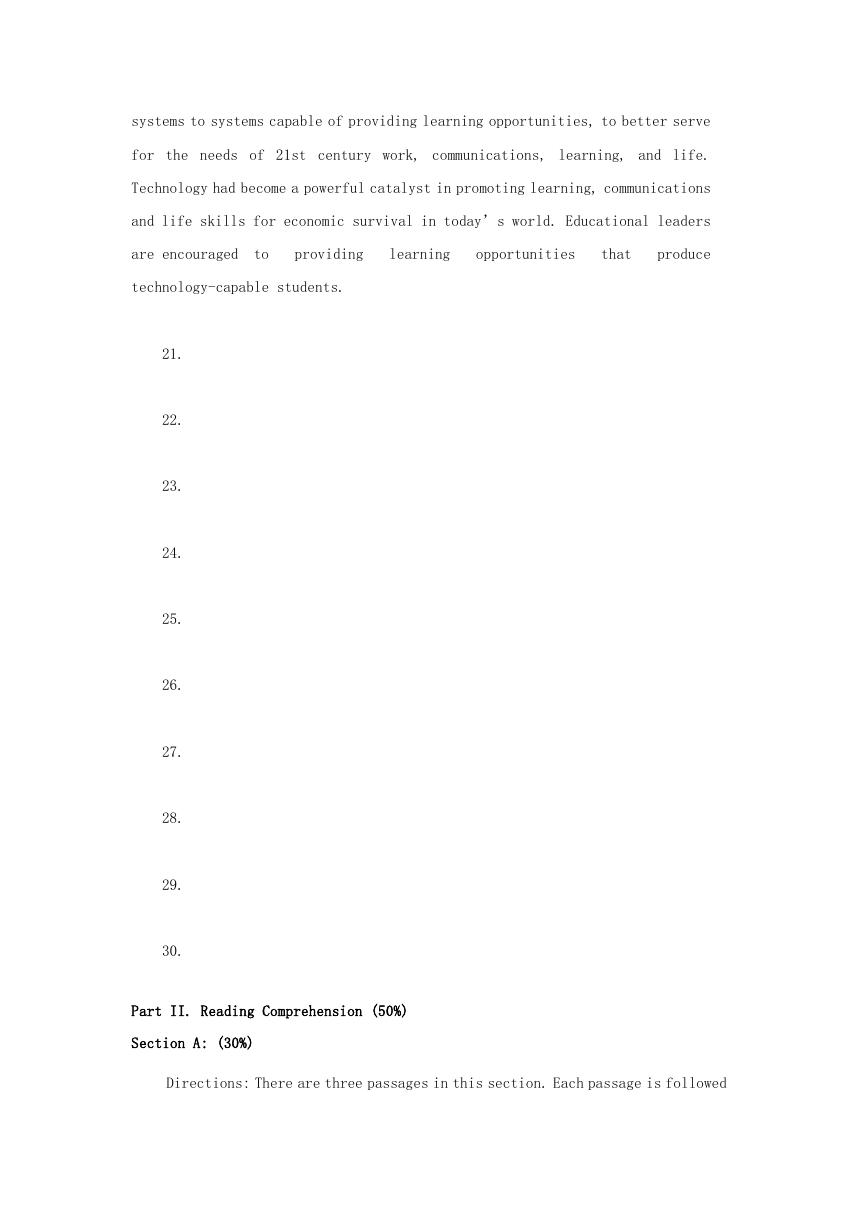
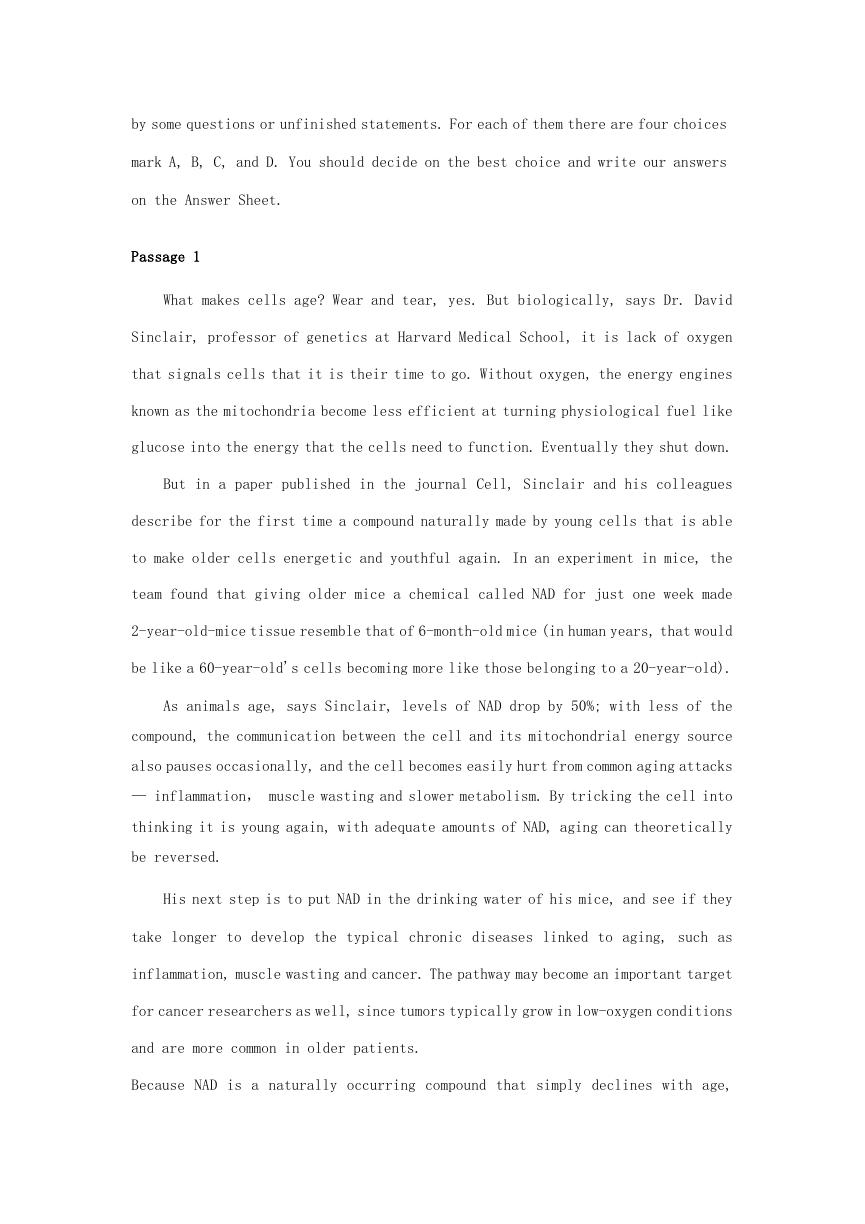
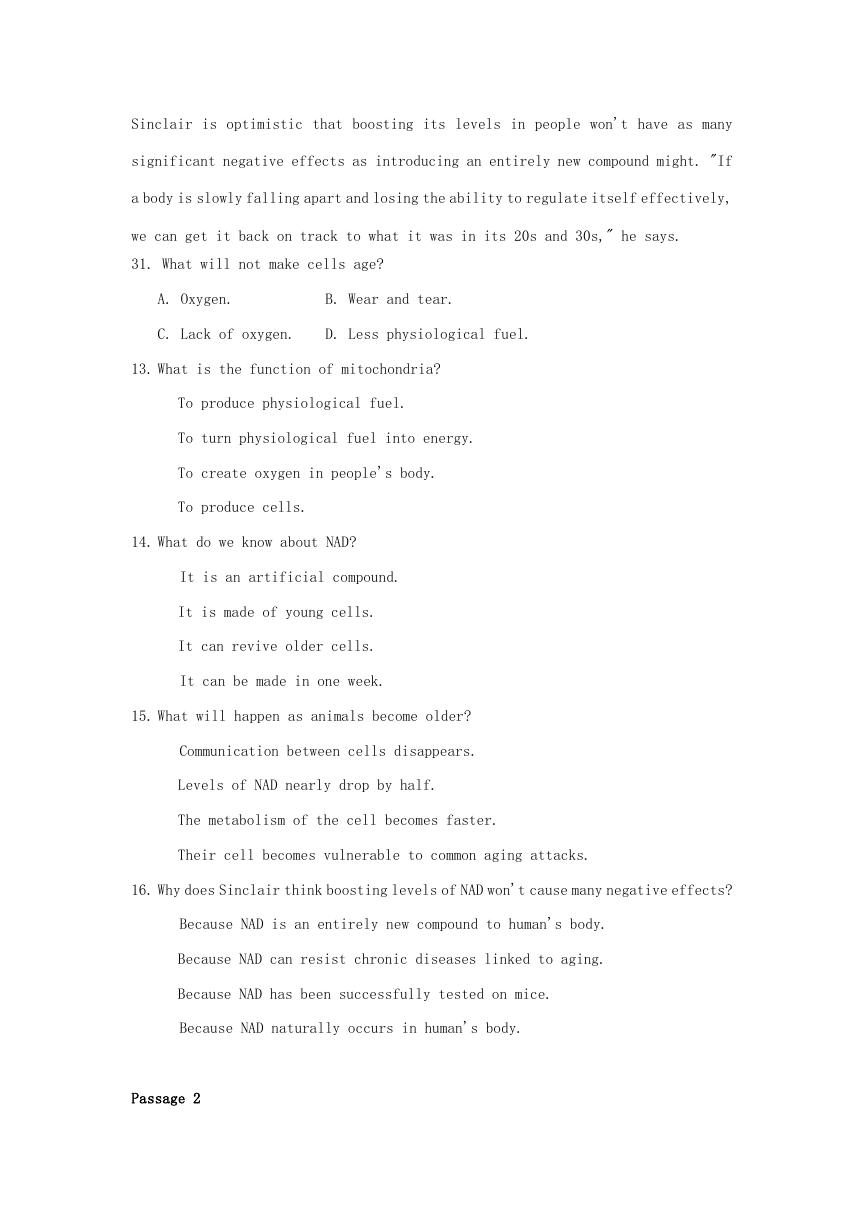
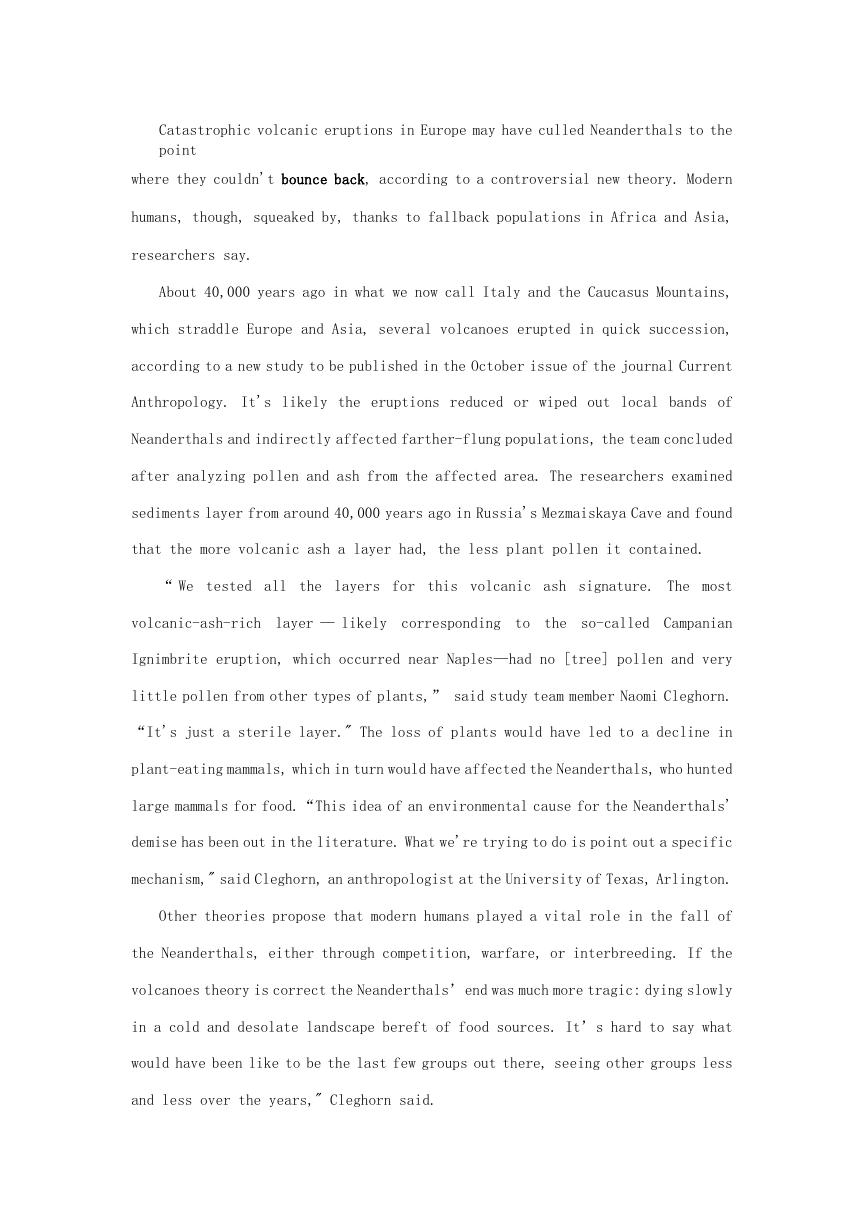
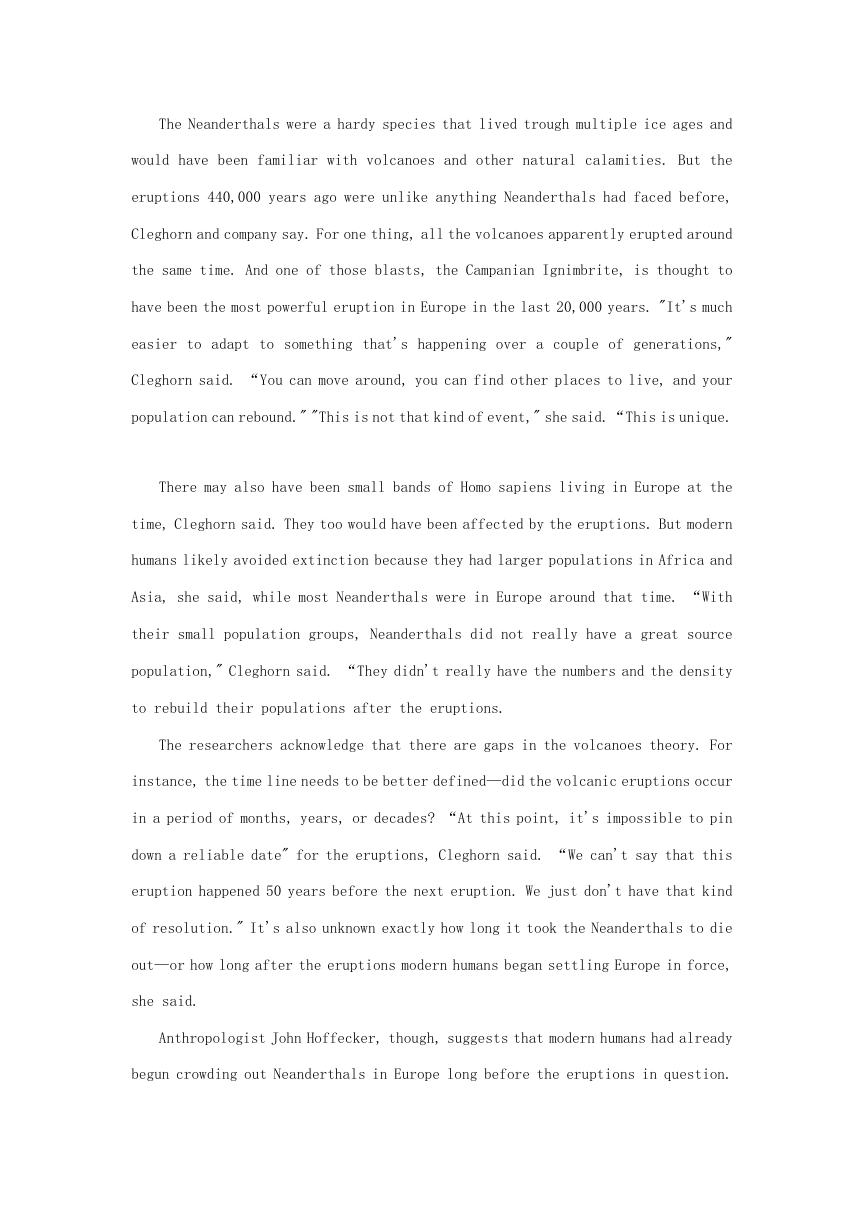








 2023年江西萍乡中考道德与法治真题及答案.doc
2023年江西萍乡中考道德与法治真题及答案.doc 2012年重庆南川中考生物真题及答案.doc
2012年重庆南川中考生物真题及答案.doc 2013年江西师范大学地理学综合及文艺理论基础考研真题.doc
2013年江西师范大学地理学综合及文艺理论基础考研真题.doc 2020年四川甘孜小升初语文真题及答案I卷.doc
2020年四川甘孜小升初语文真题及答案I卷.doc 2020年注册岩土工程师专业基础考试真题及答案.doc
2020年注册岩土工程师专业基础考试真题及答案.doc 2023-2024学年福建省厦门市九年级上学期数学月考试题及答案.doc
2023-2024学年福建省厦门市九年级上学期数学月考试题及答案.doc 2021-2022学年辽宁省沈阳市大东区九年级上学期语文期末试题及答案.doc
2021-2022学年辽宁省沈阳市大东区九年级上学期语文期末试题及答案.doc 2022-2023学年北京东城区初三第一学期物理期末试卷及答案.doc
2022-2023学年北京东城区初三第一学期物理期末试卷及答案.doc 2018上半年江西教师资格初中地理学科知识与教学能力真题及答案.doc
2018上半年江西教师资格初中地理学科知识与教学能力真题及答案.doc 2012年河北国家公务员申论考试真题及答案-省级.doc
2012年河北国家公务员申论考试真题及答案-省级.doc 2020-2021学年江苏省扬州市江都区邵樊片九年级上学期数学第一次质量检测试题及答案.doc
2020-2021学年江苏省扬州市江都区邵樊片九年级上学期数学第一次质量检测试题及答案.doc 2022下半年黑龙江教师资格证中学综合素质真题及答案.doc
2022下半年黑龙江教师资格证中学综合素质真题及答案.doc